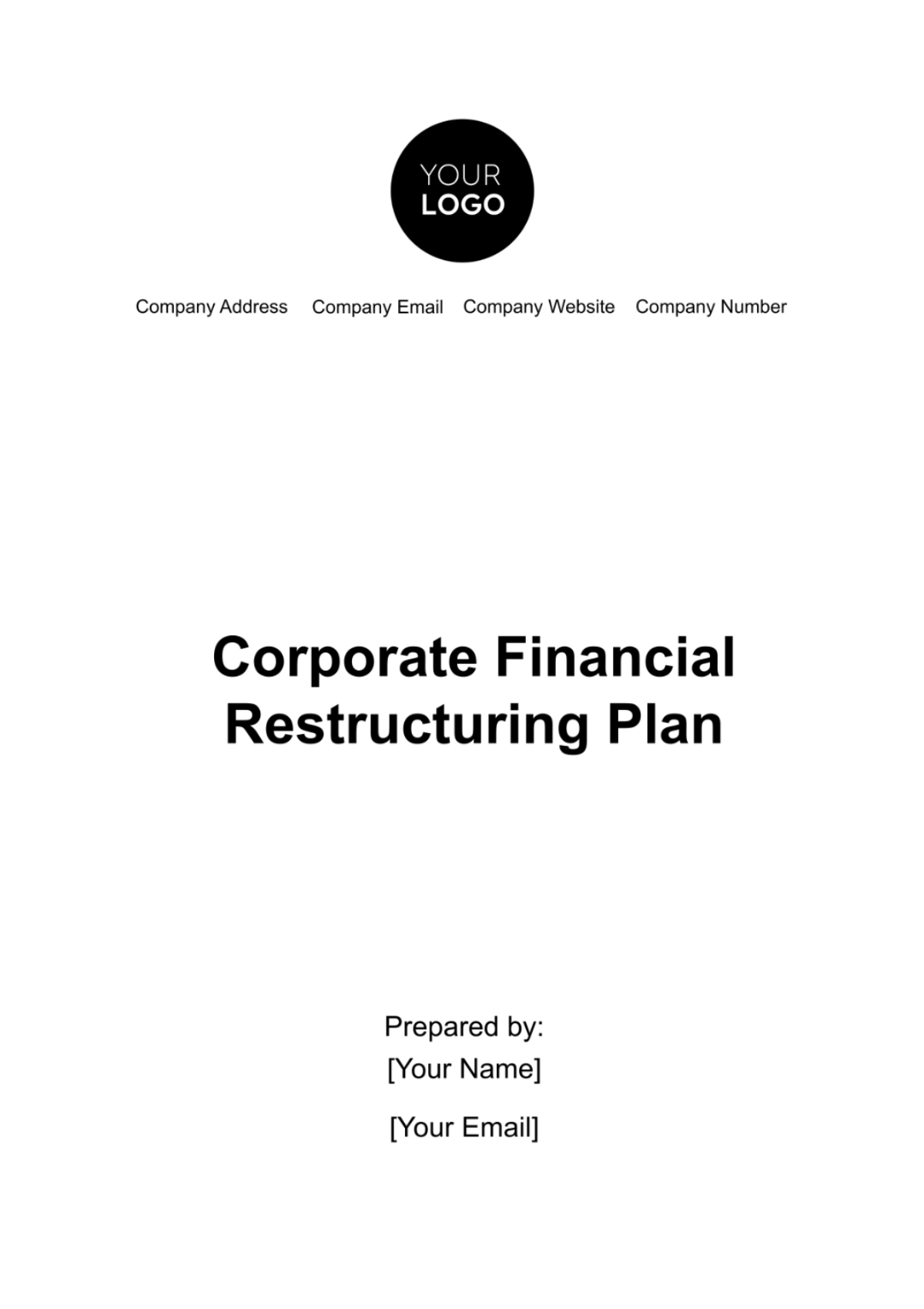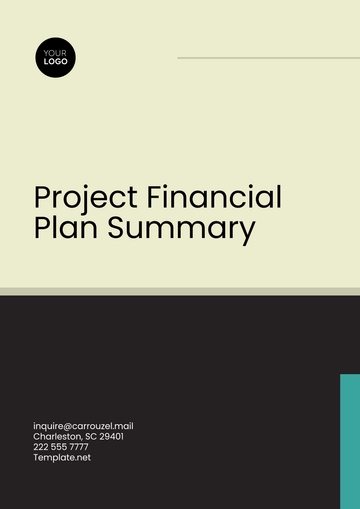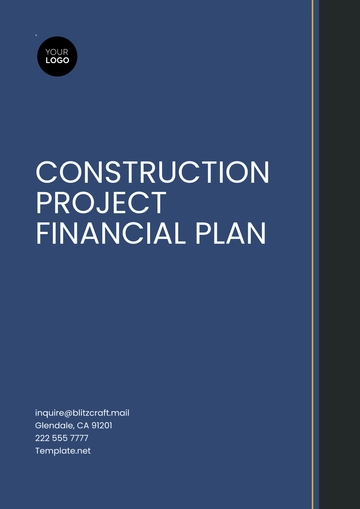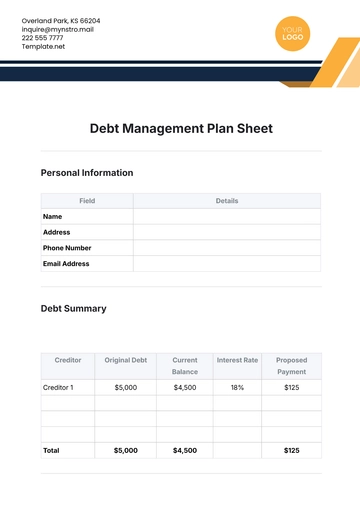Free Corporate Financial Restructuring Plan

1. Introduction
1.1 Overview
In an increasingly competitive and volatile economic landscape, it is essential for businesses to maintain financial agility and resilience. This document presents a meticulously crafted Financial Restructuring Plan for [Your Company Name], designed to navigate the complexities of today's market dynamics while laying a robust foundation for future growth. The essence of this plan is not merely to address immediate financial concerns but to spearhead a strategic transformation that aligns with the company's long-term vision and objectives.
At the core of this restructuring strategy is the commitment to enhance [Your Company Name]'s financial stability. In recent times, numerous external and internal factors have contributed to a pressing need for financial reassessment and realignment. These include market fluctuations, technological advancements, evolving consumer preferences, and competitive pressures. Our approach is tailored to address these challenges head-on, ensuring that [Your Company Name] not only survives but thrives in the current economic climate.
The overarching goal of this plan is to ensure long-term profitability and shareholder value creation. To achieve this, the strategy focuses on optimizing asset utilization, improving operational efficiencies, and restructuring the capital base. We are dedicated to building a financial structure that supports sustainable growth, fosters innovation, and enhances our competitive advantage.
1.2 Purpose
The purpose of this financial restructuring is multifaceted, aiming to achieve the following key objectives:
Realign Financial Strategies with Business Objectives: The cornerstone of our approach is to ensure that every financial decision and strategy directly contributes to the broader business goals of [Your Company Name]. This alignment is crucial for coherent and focused growth, driving operational and strategic decisions that resonate with our long-term vision.
Efficient Debt Management: A significant aspect of this plan involves a comprehensive review and restructuring of the company’s debt profile. The objective is to achieve a more favorable debt structure, potentially through refinancing, renegotiating terms, or exploring alternative financing options. This will aid in reducing the cost of capital, easing cash flow pressures, and improving the overall financial health of the company.
Optimization of Capital Structure: An optimal capital structure is key to maximizing shareholder value. The plan will assess the current mix of debt and equity to strike a balance that supports growth while minimizing risk. This may involve raising new capital, repurchasing shares, or other measures to ensure a more efficient capital structure.
Sustainability and Risk Management: In line with modern business practices, sustainability and risk management form an integral part of our financial restructuring plan. We aim to build resilience against market uncertainties, regulatory changes, and other potential risks. This includes diversifying revenue streams, enhancing operational flexibility, and implementing robust risk management protocols.
The Financial Restructuring Plan for [Your Company Name] is a comprehensive blueprint aimed at revitalizing our financial structure. It is a testament to our proactive approach in navigating the complexities of the current business environment. Through this plan, we are committed to achieving financial excellence, which is pivotal in realizing our vision of sustained growth and market leadership.
2. Company Profile
This section presents a concise profile of [Your Company Name], providing key contact and identity information. This profile serves as a foundational overview, offering essential insights into the company's primary communication channels and operational base. Understanding the company's identity and contact points is crucial for stakeholders, partners, and financial institutions, particularly in the context of the financial restructuring process.
Item | Description |
Name: | [Your Company Name] |
Email: | [Your Company Email] |
Website: | [Your Company Website] |
Address: | [Your Company Address] |
Phone: | [Your Company Phone Number] |
Social Media: | [Your Social Media] |
Each element in this profile not only represents a means of communication and interaction but also reflects the brand identity and operational presence of [Your Company Name] in the market. From digital platforms to physical location, these details collectively paint a picture of the company's accessibility, reach, and connectivity in today's interconnected business world.
3. Current Financial Status
The financial health of a company serves as the backbone of its strategic and operational decisions. In this chapter, we delve into the current financial status of [Your Company Name], providing a transparent and detailed view of our financial position as of the year [2050]. This comprehensive overview is pivotal for understanding the basis upon which our financial restructuring plan is developed and implemented.
3.1 Financial Statements Summary
Financial statements are crucial for assessing the company's financial performance and position. Below are summaries of the key financial statements for [Your Company Name] as of and for the year 2050.
Financial Statement | Description | Date |
Balance Sheet | A snapshot of the company's financial position, detailing assets, liabilities, and shareholders' equity. | [As of December 31, 2050] |
Income Statement | A summary of the company's revenues, expenses, and profitability over the year. | [For the year ended December 31, 2050] |
Cash Flow Statement | An overview of the cash inflows and outflows from operating, investing, and financing activities. | [For the year ended December 31, 2050] |
3.2 Debt Profile
A company's debt profile is a critical aspect of its financial health, influencing its risk profile and creditworthiness. Below is an overview of the debt profile of [Your Company Name] as of the year [2050].
Item | Description |
Total Outstanding Debt | [$000.00] |
Average Interest Rate | 0% |
Debt Maturity Profile | Detailed in Section 4.2 |
The total outstanding debt and the average interest rate provide insight into the current debt burden and its cost to the company. The debt maturity profile, which will be elaborated in Section 4.2, is crucial for understanding the timing of debt obligations and planning for debt servicing or restructuring.
4. Restructuring Strategies
The heart of our financial restructuring plan for [Your Company Name] lies in the carefully devised strategies aimed at revitalizing and optimizing our financial and operational structure. This chapter delineates the various approaches we will undertake to realign our assets, manage our debts, restructure our equity, and revamp our operational practices. Each of these strategies is designed to contribute significantly to our goal of achieving a more robust, agile, and financially sound organization.
4.1 Asset Realignment
The first step in our restructuring process is asset realignment. This involves critically assessing our asset portfolio and identifying opportunities to enhance financial flexibility and efficiency.
Strategy | Description | Estimated Impact |
Asset Sale | Sale of non-core assets | Raise [$000.00] |
Leaseback | Sale and leaseback of properties | Reduce capital expenditure by [$000.00] |
The asset sale strategy focuses on divesting non-essential assets, thereby generating liquidity and focusing resources on core business areas. The leaseback approach, on the other hand, involves selling properties and leasing them back, which can reduce capital expenditure and free up cash for operational needs.
4.2 Debt Restructuring
Debt restructuring is a critical component of our financial overhaul. By renegotiating the terms of our current debts, we aim to reduce financial strain and improve cash flow.
Current Debt | New Terms | Reduction in Annual Cost |
Example Loan | Lower interest rate or extended maturity | [$000.00] |
The goal here is to secure more favorable terms, such as lower interest rates or extended maturities, which can significantly reduce our annual debt servicing costs.
4.3 Equity Restructuring
Equity restructuring is another avenue through which we intend to strengthen our financial base.
Issue New Equity Shares: This will help in raising fresh capital, diluting existing debt, and improving our debt-to-equity ratio.
Repurchase or Retire Existing Shares: This strategy can be employed to enhance shareholder value and optimize our equity structure.
4.4 Operational Restructuring
We have identified two primary areas for restructuring: labor and supply chain. The strategies in these areas are carefully chosen to ensure they yield substantial benefits in terms of cost savings and operational effectiveness.
Area | Strategy | Expected Savings |
Labor | Reducing workforce/outsourcing | [$000.00] |
Supply Chain | Renegotiating supplier contracts | [$000.00] |
Labor: Our approach here involves a critical assessment of our workforce, with the objective to optimize labor costs. This may include measures such as reducing the workforce or outsourcing certain functions to achieve greater cost efficiency and focus on core competencies.
Supply Chain: In this area, the focus will be on renegotiating contracts with suppliers. This strategy is aimed at obtaining more favorable terms, which can lead to significant reductions in operational costs.
The expected savings from these initiatives are quantified to provide a clear picture of the financial impact of the operational restructuring. This strategic reconfiguration is crucial for [Your Company Name] to emerge as a more competitive and financially stable entity in the market.
5. Implementation Timeline
A well-structured plan is only as effective as its implementation. This chapter, therefore, is dedicated to outlining a clear and realistic timeline for the execution of the various strategies under the Financial Restructuring Plan for [Your Company Name]. Timely and efficient implementation is crucial to ensure that the intended financial and operational benefits are realized, and the company is steered towards stability and growth.
The implementation of the restructuring plan is divided into distinct phases, each encompassing specific activities with set completion dates. This phased approach allows for a structured and manageable progression through the plan, ensuring each aspect receives the necessary focus and resources.
Phase | Activities | Completion Date |
1 | Asset assessment & sale preparation | [Month Day Year] |
2 | Debt renegotiation | [Month Day Year] |
3 | Equity measures | [Month Day Year] |
4 | Operational changes | [Month Day Year] |
Phase 1 - Asset Assessment & Sale Preparation: The initial phase involves a thorough assessment of the company's assets and preparation for the sale of non-core assets. This phase is critical for generating liquidity and refocusing on core business areas.
Phase 2 - Debt Renegotiation: This phase is dedicated to renegotiating the terms of existing debts. The objective is to secure more favorable conditions that will ease the financial burden on the company.
Phase 3 - Equity Measures: In this phase, we will focus on equity restructuring. This includes measures such as issuing new equity shares and repurchasing or retiring existing shares, aimed at optimizing the company’s equity structure.
Phase 4 - Operational Changes: The final phase involves implementing changes in the operational structure of the company. This includes the strategies outlined in the operational restructuring section, such as labor optimization and supply chain renegotiation.
6. Financial Projections
In this crucial chapter, we provide financial projections for [Your Company Name], reflecting the anticipated impact of our comprehensive restructuring strategies over the next two years. These projections, encompassing both the income statement and the cash flow statement, are instrumental in illustrating the financial trajectory and health of the company as we implement the restructuring plan.
6.1 Projected Income Statement
The projected income statement is a forecast of our revenue, expenses, and net income for the next two years, demonstrating the expected financial performance following the restructuring.
Year | Revenue ($000) | Expenses ($000) | Net Income ($000) |
Year 1 | 125,000 | 100,000 | 25,000 |
Year 2 | 150,000 | 110,000 | 40,000 |
These figures reflect a strategic increase in revenue and a more controlled growth in expenses, leading to an improved net income over the two-year period. The increase in revenue is anticipated from expanded market reach and operational efficiencies, while the controlled expenses are a result of cost-saving measures in operations and debt restructuring.
6.2 Projected Cash Flow Statement
The cash flow statement projection is a critical component, as it provides insights into the company's cash management, highlighting the cash movements from operating, investing, and financing activities.
Year | Operating Activities ($000) | Investing Activities ($000) | Financing Activities ($000) | Net Increase in Cash ($000) |
Year 1 | 30,000 | (20,000) | 10,000 | 20,000 |
Year 2 | 35,000 | (15,000) | 5,000 | 25,000 |
In Year 1, positive cash flow from operations and financing activities outweighs the investments, leading to a net increase in cash. Year 2 continues this trend with even stronger operational cash flow and a reduced need for financing. The decrease in investing activities indicates a focus on leveraging existing assets more effectively.
7. Risk Management
During periods of restructuring and transformation, risk management is an indispensable component. Chapter 7 is dedicated to identifying potential risks that [Your Company Name] may encounter in the course of implementing our financial restructuring plan, and more importantly, to outlining the strategies we have in place to mitigate these risks. This proactive approach to risk management is critical to safeguarding the company against unforeseen challenges and ensuring the smooth execution and success of our restructuring efforts.
7.1 Risks and Mitigation Strategies
Effective risk management involves not only identifying potential risks but also developing and implementing strategies to mitigate them. Below, we detail some of the primary risks that could impact our restructuring process, along with the corresponding mitigation strategies.
Risk | Mitigation Strategy |
Market Fluctuations | Diversification, Hedging |
Regulatory Changes | Compliance Monitoring |
Operational Disruptions | Business Continuity Planning |
Market Fluctuations: The volatility of the market can pose significant risks to our financial stability. To mitigate this, we will adopt a strategy of diversification to spread risk and use hedging techniques to protect against adverse market movements.
Regulatory Changes: Changes in laws and regulations could impact various aspects of our operations and financials. We will ensure continuous monitoring and compliance with all relevant regulations, adapting our strategies as necessary to remain compliant.
Operational Disruptions: Unplanned operational disruptions can have a severe impact on our business continuity. To counter this, we have developed a comprehensive business continuity plan, ensuring that we can maintain operations and mitigate losses in the event of disruptions.
8. Conclusion
As we draw this comprehensive restructuring plan to a close, it's important to underscore the overarching aim of these efforts: to steer [Your Company Name] towards a future marked by robust financial stability and sustainable growth. The strategies laid out in this document, ranging from asset realignment to operational restructuring, are meticulously crafted to catalyze a transformation that will reshape the financial and operational contours of our organization. However, the success of this plan hinges not just on the strategies themselves but significantly on the collective commitment and concerted efforts of all stakeholders involved.
Each stakeholder, from employees and management to investors and partners, plays a pivotal role in the effective implementation of this plan. It is through our unified dedication and relentless pursuit of excellence that we can transform these strategies from plans on paper into tangible results. The journey we are embarking upon may present its challenges, but with our combined resolve and focus, we are poised to navigate these complexities and emerge stronger.
In essence, this plan is more than a set of financial maneuvers; it is a roadmap for the future of [Your Company Name], a future where financial resilience and growth are not just aspirations but achievable realities. With this plan as our guide and our stakeholders as our allies, we are ready to move forward, adapting, growing, and thriving in the dynamic business landscape of tomorrow.
- 100% Customizable, free editor
- Access 1 Million+ Templates, photo’s & graphics
- Download or share as a template
- Click and replace photos, graphics, text, backgrounds
- Resize, crop, AI write & more
- Access advanced editor
Craft a financial masterpiece with Template.net's Corporate Financial Restructuring Plan Template. Fully editable and customizable, it puts you in control of your financial destiny. Utilize our Ai Editor Tool to tailor your plan with precision. Navigate the intricacies of restructuring effortlessly and secure your corporate future with Template.net's cutting-edge solutions.
You may also like
- Finance Plan
- Construction Plan
- Sales Plan
- Development Plan
- Career Plan
- Budget Plan
- HR Plan
- Education Plan
- Transition Plan
- Work Plan
- Training Plan
- Communication Plan
- Operation Plan
- Health And Safety Plan
- Strategy Plan
- Professional Development Plan
- Advertising Plan
- Risk Management Plan
- Restaurant Plan
- School Plan
- Nursing Home Patient Care Plan
- Nursing Care Plan
- Plan Event
- Startup Plan
- Social Media Plan
- Staffing Plan
- Annual Plan
- Content Plan
- Payment Plan
- Implementation Plan
- Hotel Plan
- Workout Plan
- Accounting Plan
- Campaign Plan
- Essay Plan
- 30 60 90 Day Plan
- Research Plan
- Recruitment Plan
- 90 Day Plan
- Quarterly Plan
- Emergency Plan
- 5 Year Plan
- Gym Plan
- Personal Plan
- IT and Software Plan
- Treatment Plan
- Real Estate Plan
- Law Firm Plan
- Healthcare Plan
- Improvement Plan
- Media Plan
- 5 Year Business Plan
- Learning Plan
- Marketing Campaign Plan
- Travel Agency Plan
- Cleaning Services Plan
- Interior Design Plan
- Performance Plan
- PR Plan
- Birth Plan
- Life Plan
- SEO Plan
- Disaster Recovery Plan
- Continuity Plan
- Launch Plan
- Legal Plan
- Behavior Plan
- Performance Improvement Plan
- Salon Plan
- Security Plan
- Security Management Plan
- Employee Development Plan
- Quality Plan
- Service Improvement Plan
- Growth Plan
- Incident Response Plan
- Basketball Plan
- Emergency Action Plan
- Product Launch Plan
- Spa Plan
- Employee Training Plan
- Data Analysis Plan
- Employee Action Plan
- Territory Plan
- Audit Plan
- Classroom Plan
- Activity Plan
- Parenting Plan
- Care Plan
- Project Execution Plan
- Exercise Plan
- Internship Plan
- Software Development Plan
- Continuous Improvement Plan
- Leave Plan
- 90 Day Sales Plan
- Advertising Agency Plan
- Employee Transition Plan
- Smart Action Plan
- Workplace Safety Plan
- Behavior Change Plan
- Contingency Plan
- Continuity of Operations Plan
- Health Plan
- Quality Control Plan
- Self Plan
- Sports Development Plan
- Change Management Plan
- Ecommerce Plan
- Personal Financial Plan
- Process Improvement Plan
- 30-60-90 Day Sales Plan
- Crisis Management Plan
- Engagement Plan
- Execution Plan
- Pandemic Plan
- Quality Assurance Plan
- Service Continuity Plan
- Agile Project Plan
- Fundraising Plan
- Job Transition Plan
- Asset Maintenance Plan
- Maintenance Plan
- Software Test Plan
- Staff Training and Development Plan
- 3 Year Plan
- Brand Activation Plan
- Release Plan
- Resource Plan
- Risk Mitigation Plan
- Teacher Plan
- 30 60 90 Day Plan for New Manager
- Food Safety Plan
- Food Truck Plan
- Hiring Plan
- Quality Management Plan
- Wellness Plan
- Behavior Intervention Plan
- Bonus Plan
- Investment Plan
- Maternity Leave Plan
- Pandemic Response Plan
- Succession Planning
- Coaching Plan
- Configuration Management Plan
- Remote Work Plan
- Self Care Plan
- Teaching Plan
- 100-Day Plan
- HACCP Plan
- Student Plan
- Sustainability Plan
- 30 60 90 Day Plan for Interview
- Access Plan
- Site Specific Safety Plan





























